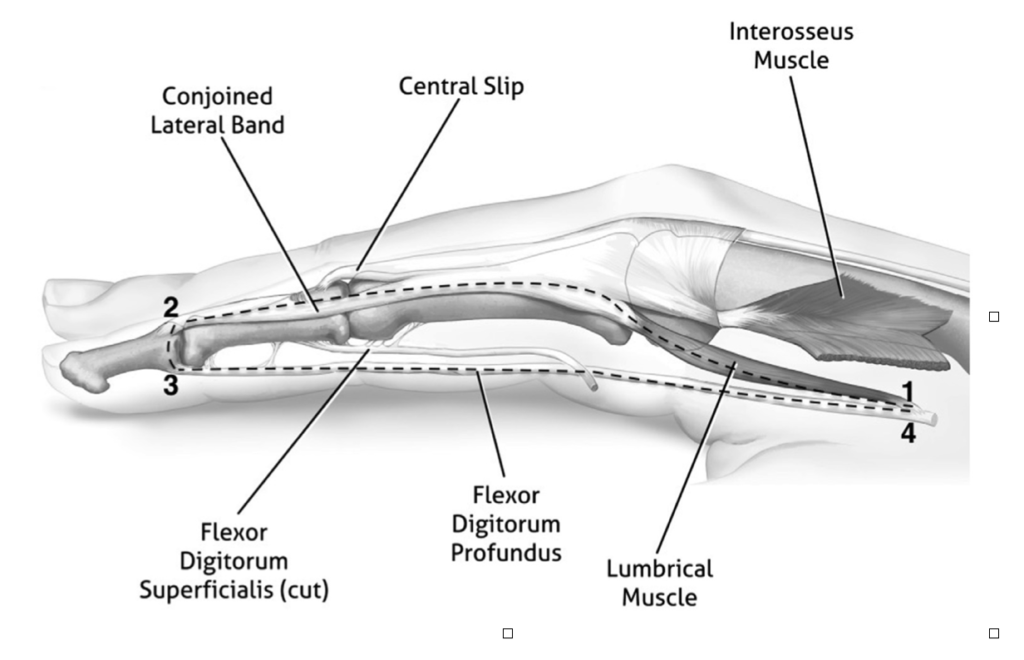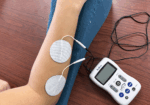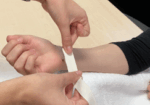Crowley, J. S., Meunier, M., Lieber, R. L., & Abrams, R. A. (2020). The Lumbricals Are Not the Workhorse of Digital Extension and Do Not Relax Their Own Antagonist. The Journal of Hand Surgery.
The Skinny:
What do the lumbricals do?
There is a long-standing belief that the lumbricals act as a counterforce to the digital flexors enough to relax the digital flexors and act as primary digital extensors. This article works to update our understanding of the role of the lumbrical based on anatomy and innervation. They build off the work of Wang et al. to develop a better understanding of what the lumbricals function actually is in digit extension and balance of forces.
In The Weeds:
To review the anatomical line of the lumbricals, check out the picture below. Also, the lumbricals have several unique properties. They have the highest spindle fiber density of any UE muscle (a property of muscles intended for refined graded control, not power). They also have the highest fiber length-to-muscle length ratio. This means that the lumbricals are best at providing a low amount of force over a wide range of motion. These two aspects refute the idea that the lumbricals are strong enough to overpower counterbalance the much larger, conversely designed, FDP & FDS.

Crowley, J. S., Meunier, M., Lieber, R. L., & Abrams, R. A. (2020). The Lumbricals Are Not the Workhorse of Digital Extension and Do Not Relax Their Own Antagonist. The Journal of Hand Surgery.
Bringing It Home:
So what? What does that mean? Rather than the lumbricals being some powerhouse of IP extension, this article builds on the Wang articles proposal. Want et al. propose that the lumbricals are a tension monitoring device that allows for refined motor coordination to aid in coordinating the stronger extrinsic muscles. Crowley et al. add to that and suggest that the lumbricals also serve as a spring in a closed loop that helps to balance the 2nd and 3rd phalanx over the 1st, since the 1st phalanx has no tendon insertions to maintain its position. That makes the 1st phalanx an intercalated segment that needs delicately maintained tension to preserve its position. This is a significant shift in the idea that the lumbricals are a strong force in digital extension, counteracting the FDP & FDS.
Rating: 5/5
While not a research study, this article adds a lot of understanding and clarification of the anatomy and role of the lumbricals. Looking at muscle size, length, fiber type, and anatomical attachment can improve our awareness of a unique muscle like this is actually doing in the hand. It is always good to stay open-minded to alternative views of our sometimes dogmatically held opinions and beliefs. There are many more significant pieces of info in this article, and I highly recommend reading it if you have a chance.
Wang K, McGlinn EP, Chung KC. A biomechanical and evolutionary perspective on the function of the lumbrical muscle. J Hand Surg Am. 2014;39(1):149e155.
1 Comment
Leave a Comment
More To Read
Hand Therapy Marketing 101
Marketing 101 – 5 Tips for Your Therapy Clinic Confession: I hate marketing. It’s my least favorite part of my job. It is so hard to open yourself up to that much rejection but still stay positive. It feels like the professional version of blind dating, except the other person probably already has a significant…
Read MoreRadial Nerve Palsy: A Paralysis Causing Wrist Drop
Radial Nerve Palsy- Treatment
Read MoreDorsal Wrist Pain?
Incorporating Emerging Evidence into Clinical Practice for Patients Experiencing Dorsal Wrist Pain During Weight-Bearing Activities By: Brittany Day Supporting Evidence A randomized control study recently published in the Journal of Hand Therapy found rigid carpal stabilizing taping (CST) to significantly increase passive range of motion, active range of motion, and decrease pain in patients experiencing…
Read MorePediatric & Adolescent Shoulder Instability
Lin, K.M, James, E.W., Spitze, E. & Fabricant, P.D. (2018). Pediatric and adolescent anterior shoulder instability: Clinical management of first-time dislocators. Current opinion in pediatrics, 30, 49-56. doi: 10.1097/MOP.0000000000000566. The Skinny: Shoulder instability for pediatric and adolescent patients is fairly common and is often complicated by a high re-dislocation rate. Shoulder instability typically occurs after…
Read MoreSign-up to Get Updates Straight to Your Inbox!
Sign up with us and we will send you regular blog posts on everything hand therapy, notices every time we upload new videos and tutorials, along with handout, protocols, and other useful information.







Great explanation and illustration